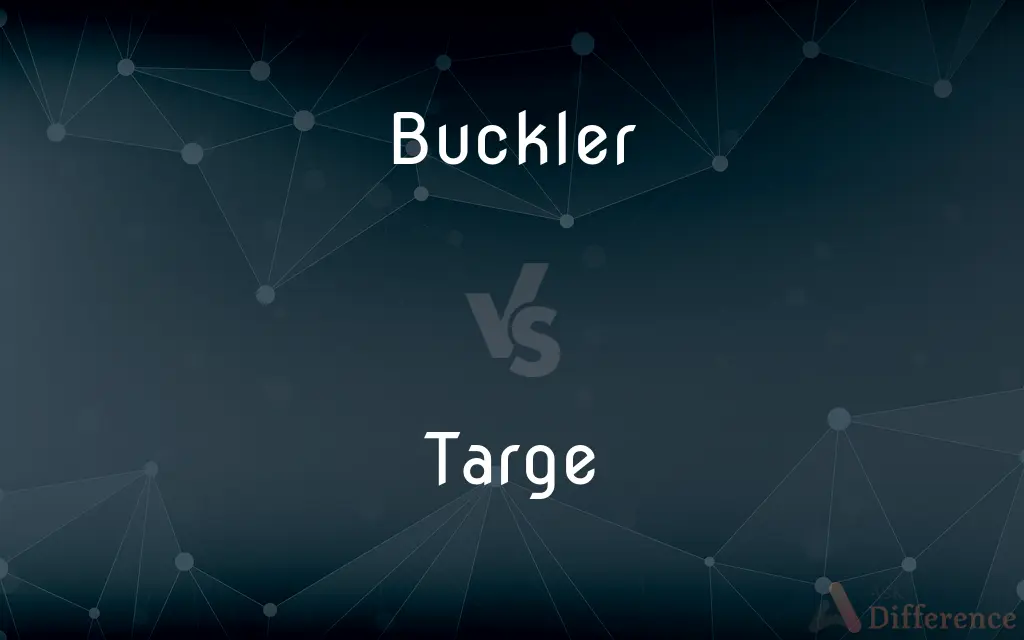Buckler vs. Targe — What's the Difference?
By Maham Liaqat & Urooj Arif — Updated on April 27, 2024
A buckler is a small, round shield used in hand-to-hand combat, offering high mobility, while a targe is larger, typically square or round, used mainly by Scottish warriors for broader protection.

Difference Between Buckler and Targe
Table of Contents
ADVERTISEMENT
Key Differences
A buckler, often about 15 to 45 cm in diameter, is designed for quick, close-quarters fighting, enhancing a combatant's agility. Whereas a targe, larger with diameters up to 60 cm, provides more extensive coverage and was traditionally employed for battles involving ranged and melee tactics.
Bucklers are highly maneuverable, allowing fighters to deflect blows and quickly counterattack, making them ideal for dueling scenarios. On the other hand, targes were more commonly used to absorb impacts from larger weapons and could even be used offensively to push opponents back in skirmishes.
The construction of a buckler typically involves a solid piece of metal or wood with a central handle behind the boss (the shield's raised central part). In contrast, targes are often more elaborately designed, featuring layers of wood covered by leather or metal, often adorned with additional elements like spikes or brass nails for added functionality and aesthetics.
Bucklers were predominantly used in Europe from the Middle Ages through the Renaissance and were part of the standard equipment for soldiers and duelists. On the other hand, targes are specifically associated with Scottish Highland warriors from the 16th to the 18th centuries and are iconic for their role in clan warfare and national defense.
While bucklers are typically used in conjunction with swords or rapiers, enhancing a fighter’s defense without greatly impeding offense, targes were often paired with broadswords and axes, providing a balance between offense and defense in battle-heavy scenarios.
ADVERTISEMENT
Comparison Chart
Size
Small (15-45 cm diameter)
Larger (up to 60 cm diameter)
Shape
Round
Typically round, sometimes square
Usage
Hand-to-hand combat, dueling
Battle formation, skirmishes
Construction
Metal or wood with a central handle
Layers of wood, leather, metal; often adorned
Historical Context
Europe, Middle Ages to Renaissance
Scotland, 16th to 18th century
Compare with Definitions
Buckler
A small round shield used in fighting.
He deflected the blow with his buckler and swiftly counterattacked.
Targe
Designed to absorb significant impacts.
His targe absorbed the brunt of the enemy's axe without yielding.
Buckler
Often used in combination with a sword.
The swordsman paired his rapier with a buckler for the duel.
Targe
A large, often decorative shield used by Scottish warriors.
The targe was adorned with intricate designs and served as both protection and a symbol of clan identity.
Buckler
Portable shield carried by soldiers or duelists.
The buckler at his side was battered from numerous duels.
Targe
Used in traditional Scottish combat.
Highlanders raised their targes to form a defensive line against the cavalry.
Buckler
Designed for rapid movement and reaction.
Using the buckler requires skill to turn defense into offense quickly.
Targe
A key element in Scottish historical warfare.
The targe was essential for survival in the rugged terrain and fierce clan wars of Scotland.
Buckler
A defensive aid in close combat.
In close combat, his buckler was his best defense against the opponent's strikes.
Targe
Often paired with a broadsword.
Clutching his targe and broadsword, he charged into battle.
Buckler
A buckler (French bouclier 'shield', from Old French bocle, boucle 'boss') is a small shield, up to 45 cm (up to 18 in) in diameter, gripped in the fist with a central handle behind the boss. While being used in Europe since antiquity, it became more common as a companion weapon in hand-to-hand combat during the Medieval and Renaissance periods.
Targe
Targe (from Old Franconian *targa "shield", Proto-Germanic *targo "border") was a general word for shield in late Old English. Its diminutive, target, came to mean an object to be aimed at in the 18th century.
Buckler
A small round shield held by a handle or worn on the forearm.
Targe
A light shield or buckler.
Buckler
A small, round shield either carried in the hand or worn on the arm.
Targe
(archaic) A small shield.
Buckler
One who buckles something.
Targe
(archaic) A pendant or tassel.
Buckler
A kind of shield, of various shapes and sizes, held in the hand or worn on the arm (usually the left), for protecting the front of the body. In the sword and buckler play of the Middle Ages in England, the buckler was a small shield, used not to cover the body but to stop or parry blows.
Targe
A shield or target.
Buckler
(obsolete) A shield resembling the Roman scutum. In modern usage, a smaller variety of shield is usually implied by this term.
Buckler
(zoology) One of the large, bony, external plates found on many ganoid fishes.
Buckler
(zoology) The anterior segment of the shell of a trilobite.
Buckler
(nautical) A block of wood or plate of iron made to fit a hawse hole, or the circular opening in a half-port, to prevent water from entering when the vessel pitches.
Buckler
To shield; to defend.
Buckler
A kind of shield, of various shapes and sizes, worn on one of the arms (usually the left) for protecting the front of the body.
Buckler
One of the large, bony, external plates found on many ganoid fishes.
Buckler
A block of wood or plate of iron made to fit a hawse hole, or the circular opening in a half-port, to prevent water from entering when the vessel pitches.
Buckler
To shield; to defend.
Can Oxford, that did ever fence the right,Now buckler falsehood with a pedigree?
Buckler
Armor carried on the arm to intercept blows
Common Curiosities
What is the primary use of a buckler?
A buckler is primarily used to deflect enemy blows during close-quarters combat, enhancing mobility and counterattack speed.
Can bucklers be used effectively against ranged weapons?
Bucklers are less effective against ranged weapons due to their small size, primarily designed for hand-to-hand combat.
How does a targe differ in design from other shields?
A targe is distinctively layered with wood and leather, often featuring decorations like metal studs, spikes, or intricate patterns.
What role did the targe play in Scottish warfare?
The targe was central to traditional Scottish warfare, used both defensively and as a charge element in battle formations.
Are modern replicas of targes and bucklers used today?
Yes, modern replicas are used in historical reenactments, martial arts training, and as decorative items.
Is there a difference in the fighting techniques used with a targe versus a buckler?
Yes, targe techniques often involve using the shield's weight to off-balance opponents, while buckler techniques focus on deflection and rapid maneuverability.
Did the design of targes vary by region in Scotland?
Yes, targe designs could vary subtly depending on regional styles and the specific needs of the clan.
What historical period is the targe associated with?
The targe is closely associated with Scottish warriors from the 16th to the 18th centuries.
How does the weight of a targe compare to a buckler?
Targes are generally heavier than bucklers due to their larger size and the materials used, which include multiple layers and adornments.
What is the significance of the decorations on a targe?
Decorations on a targe often had ceremonial significance and represented clan affiliations or personal achievements.
How did fighters carry their bucklers when not in combat?
Bucklers were typically small enough to be carried on the belt or held by hand, ready for quick deployment.
Can bucklers be used defensively against larger shields?
Yes, though bucklers are small, skilled users can effectively use them to exploit the openings in an opponent's defense, even against larger shields.
What materials were traditionally used to make bucklers?
Bucklers were commonly made from metal or wood, designed to be both light and durable.
Were bucklers used in any famous historical battles?
Bucklers were commonly used in individual duels rather than large-scale battles, being more personal defense tools.
How has the perception of targes and bucklers changed over time?
While originally practical military equipment, targes and bucklers are now often viewed as historical or cultural symbols, reflecting their historical uses and artistic craftsmanship.
Share Your Discovery

Previous Comparison
Invitee vs. Inviter
Next Comparison
Handsome vs. SmartAuthor Spotlight
Written by
Maham LiaqatCo-written by
Urooj ArifUrooj is a skilled content writer at Ask Difference, known for her exceptional ability to simplify complex topics into engaging and informative content. With a passion for research and a flair for clear, concise writing, she consistently delivers articles that resonate with our diverse audience.















































